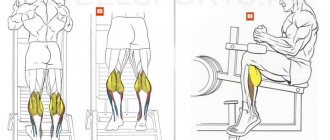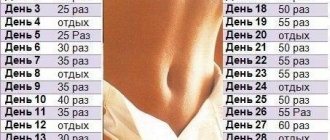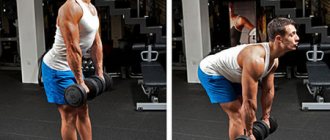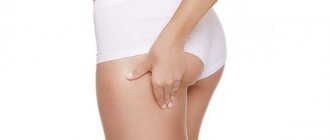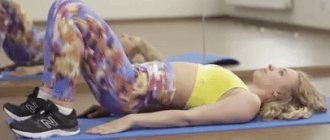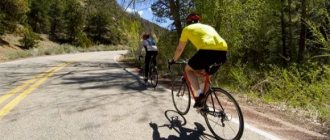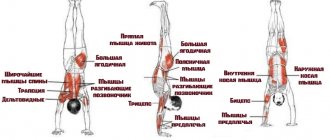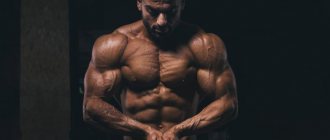The calves are responsible for moving the feet and stabilizing the body's position in space. The way the calf muscles look is mainly determined by hereditary factors. It also happens that gym regulars easily develop all muscle groups, but due to genetics they are unable to enlarge their calves. Let's try to figure out how to pump up your calves and what exercises are required for this.
Anatomy and function of the gastrocnemius muscle
The calves of a person's legs are located on the back of the legs (between the knee and ankle joints). At one end the calf is attached to the femur, at the other it smoothly passes into the Achilles tendon. The structure of the calf muscle: two large “heads”:
- medial (internal);
- lateral (external).
The functions of the gastrocnemius muscle are: flexion and extension of the foot (for example, when raising toes), indirect participation in the movement of the knee joint, maintaining a vertical position of a person, stabilizing the body during movement.
In addition, it is the calf muscles that create a powerful pushing impulse when jumping.
Types of diseases
Pain in the soleus muscle is a universal symptom that can occur in different diseases. Since the blood supply originates from the popliteal arteries, endothelial cavities (sural sinus) are formed in the thickness of the muscles.
| Stenosolia | A disease that is characterized by narrowing, squeezing pain in the red muscle, lasting more than a minute. Covers one part of the middle section from the outer or inner side of the fibula. It manifests itself as excruciating pain with burning and numbness. If you palpate the edges of the muscle along the lateral and medal heads, you can determine the hypertonicity of the area. |
| Polymyositis | An autoimmune disease of the soleus muscle, which manifests itself as intoxication and dull pain when moving. The muscle becomes swollen and painful on palpation, after a while nodules, fibrosis, and calcifications are felt. |
| Myositis | Oncological, parasitic disease, complicated by a cold, injury or overexertion. |
| Fibromyalgia | A disease of autoimmune origin, manifested by intense constant pain, severe weakness in the soleus muscle, which is in daily morning stiffness. |
| Crumpy | A brief, localized, painful cramp that squeezes and tightens a muscle. Muscle contraction occurs slowly and lasts from 1 second to 1 minute. The reason lies in the disruption of the nutrition of nerve endings. Cramps occur at night or after strenuous exercise. |
| Calf muscle rupture | The symptom of a rupture is almost impossible to distinguish from overvoltage. If the cause of the pain is not identified in time and periodic exercise is given, the muscle may tear. It manifests itself as a sharp and acute pain, the presence of something burst or torn. |
Features of calf training
To build powerful calf muscles, you should adhere to certain training principles. We have collected recommendations from professional athletes for you:
- Work your calves no more than twice a week. If you exercise too frequently, the risk of developing overtraining increases;
- After strength training for the calf muscles, do not do intense cardio, otherwise growth will slow down;
- Use a basic strength training regimen - do 3-5 sets of 6-8 repetitions;
- Increase your weight loads regularly. Otherwise, the calves will quickly “adapt” and their growth will slow down;
- Add variety. For example, perform calf raises on both upright and seated machines;
- Shift the emphasis of the load when raising your toes: the feet are turned to the sides - the medial heads work, the feet are brought inward - the lateral bundles are strengthened. With a parallel position, the load is distributed evenly over the entire back surface of the legs.
By the way, it is impossible to pump up voluminous calves at home with the help of numerous calf raises. Such exercises do not provide the strength load necessary for hypertrophy of muscle fibers.
Prevention
To avoid pain in the soleus muscle, you need to follow some rules:
- Avoid fatty foods if you have vascular problems
- Make adjustments to your weight
- Use exercises every day to strengthen your muscles.
- With a sedentary lifestyle, it is important not to forget about morning exercises.
- When training, pay attention to your body’s signals; if there is discomfort, you need to stop.
- Warm up correctly, starting to warm up your muscles with a light jog.
- After intense training, do not forget about stretching.
A set of exercises for calves from Iron Arnie
First, let's say a few words about warming up. “Warming up” is necessary for productive muscle work and reducing the risk of accidental injury. Therefore, before starting the lesson, perform simple elements: squats without weight, rotations in the hip, knee, ankle joints, bending forward on straight legs.
Most of the calf exercises below can be done at the gym, but there is one that you can do at home.
Seated calf raises
- We sit down in a special exercise machine for calves.
- We place our socks on the edge of the platform.
- We lower our heels down, but keep them suspended.
- We rest our knees on the cushion.
- As you exhale, strain your calves and raise your shins onto your toes.
- We maintain a 2-second pause, then, inhaling, smoothly lower the heels to the starting position.
5 sets of 6-8 reps. Rest between sets – 50-60 seconds. We use this time for a light massage of the legs.
Exercise "Donkey"
This calf exercise can be done at home.
- We stand with our toes on the edge of a low platform (for example, a step board).
- We lean forward and place our hands on the frame of any exercise machine.
- At this time, the partner sits on our lower back. From this position, as you exhale, we lift up on your toes.
- While inhaling, we return to the starting position, without lowering our heels to the floor.
The number of sets of repetitions is 5 to 6-8, resting no more than a minute between sets. Periodically massage the back surface of the legs.
Standing calf raises
- We stand in a vertical calf machine.
- We press our toes to the edge of the platform, lower our heels down, but keep them suspended.
- The position of the feet is parallel.
- With an exhalation, we strain our calves and rise onto our toes.
- We hold for a couple of seconds, then, inhaling, smoothly lower to the starting position.
Number of approaches 5, repetitions 6-8. Rest between approaches for no more than 1 minute. During the pause, massage the back surface of the shins.
Toe press in the simulator
- We sit down on the leg press machine.
- We press our toes to the bottom edge of the platform, positioning is parallel.
- The legs are fixed in one position.
- We remove the stops and begin to squeeze the weight with our toes: push as you exhale, and lower as you inhale.
When performing this, push the platform out smoothly, avoiding sudden tosses. We do 5 sets of 6-8 repetitions. Rest between approaches – no more than a minute. During the pause, massage your shins.
Smith machine calf raise
Not every fitness room has a machine for vertical calf raises. You can use a Smith machine instead.
- So, place a low barbell or step platform under the sliding bar.
- Remove the bar from the supports and place it on your shoulders.
- Stand with your toes on the edge of the stand and bend your knees slightly.
- As you exhale, rise onto your toes, and as you inhale, lower yourself.
Perform 5 sets and 6-8 reps.
Calf raises with dumbbells
If you can't go to the gym, strengthen your calves at home.
- Take two dumbbells and stand straight.
- As you exhale, rise up onto your toes, while inhaling, lower yourself.
- To complicate the technique, use a sock stand (10-12 cm).
Do 3-4 sets of 15-20 repetitions.
Single leg calf raise
The exercise can also be done on one leg.
- To do this, stand with your right toe on a hill and keep your left leg suspended.
- Use your left hand to hold onto a support for balance.
- Take a dumbbell in your right palm and perform lifts.
- Then repeat with the other leg.
Perform 3-4 sets of 15-20 repetitions.
Note that the last 2 exercises will not pump up your calves, but will only strengthen the shin area, since calves require large weights.
Causes of organ diseases.
The soleus muscle is in the stage of movement when the ankle joint extends and the muscle venous pump functions.
- Pain occurs during physical activity. If a person has untrained muscles, his legs will hurt after running. This happens because the tissues accumulate lactic acid during heavy exercise, without having time to be eliminated properly, and the human body, in turn, begins to experience pain.
- Pain may occur when standing motionless or tense for a long time. For example, on an airplane, at your desk, walking on your toes. The blood begins to stagnate, the muscle pump stops working, and because of this, blood stops flowing from the legs to the heart. The arteries accumulate endotoxins, circulation and oxygen supply are disrupted - all this leads to severe pain. You can correct everything by raising your legs to the level of your heart and holding them in this position for 15-30 minutes.
- If a person works in the same position and the ego cannot be changed, varicose veins of the limbs form. This disease can be prevented only with the use of daily prevention. You can do light exercise or, if possible, elevate your legs on a pillow.
- Flat feet also cause pain in the soleus muscle. The shape of the feet changes with age, and walking becomes difficult, pain appears up to the knee area. To solve this problem, physical therapy is used and specialized shoes for flat feet are worn. But first you need to visit a doctor.
- The human body has many parasites, and those that are harmful to health can become colonized. These include trisinellosis larvae. Due to their penetration into muscle tissue, severe pain, allergies and fever are felt.
- Nerves have a strong influence on the well-being of the legs. When the sciatic nerve is inflamed, pain is felt in the buttocks, which then goes down. The reasons for this phenomenon are varied, but doctors are inclined to diabetes mellitus.
- Cramps are not a rare cause of muscle pain. Contractions and sharp pain occur. This happens if the body is dehydrated and not filled with magnesium, potassium, and calcium.
- Any disease of the spine also leads to muscle pain, which begins in the lower extremities, but there is no pain in the vertebrae. Excess weight, in turn, affects the health of the spine and legs. Therefore, all diseases are interconnected, regardless of age.
- Cellulite inflammation with ulcers mainly causes pain in the legs. When the skin is damaged, pathogenic microorganisms penetrate the cells. Therefore, this can lead to severe pain, high fever, and weakness.
Recommendations for calf exercises
To ensure that the calf muscle exercises discussed above are as productive as possible, follow these tips:
- For all calf raises, keep your feet in the same position. Before starting the movement, bend your knees slightly and lock them until the end of the approach. If this is not done, the calves will not stretch when performing, which will reduce the effectiveness of the exercise;
- Focus on working the target muscles. At the bottom of the exercises you should feel a strong stretch in your calf muscles, at the top you need to contract them as much as possible. This is the only way you can effectively work out the muscles of your lower legs;
- After doing calf strength exercises, do another set of vertical raises. Use light weights for as many reps as possible. This “pumping” will improve the blood supply to the fibers and accelerate their growth;
- We recommend training your calves on the same day as your lower body workout. Moreover, if you perform power squats for 6-8 repetitions, then the weight of the “calf raises” should be reduced so as not to “catch” overtraining of the lower leg muscles;
- When performing calf exercises at home, be sure to use weights. Available items will do: a backpack with books, bottles of water, etc. Let us remind you that home exercises will only help strengthen your legs, not pump them up.
- The exercises for the calf muscles discussed in the article are suitable for both men and women. The only difference is in the loads. Women, as a rule, strive to tighten their legs, not pump them up. Therefore, girls should perform exercises with light weight for 4-5 sets of 15-20 repetitions.
Diagnostics
The pathology of pain in the soleus muscle is determined by clinical and instrumental studies. By contacting a doctor, he will rule out causes that pose a health hazard - thrombophlebitis, thrombosis, cancer and various infections.
Inflammation of veins and blood clots are determined by Doppler ultrasound system. Blood patency problems are determined, and transillumination will show damaged veins. The use of duplex angioscanning will show the condition of the blood clots, their age, and the state of the lumen.
If the doctor suspects that the muscles hurt due to the spine, he prescribes X-ray examinations of the hip joints and pelvic-sacral joint. Magnetic resonance imaging is also used, and a blood test will show the percentage of trace elements in the blood.
Medications
The soleus muscle is located between the shin bone and the gastrocnemius muscle. If the gastrocnemius muscle shortens or increases in diameter, it creates pressure on the soleus muscle, pushing it towards the tibia. Therefore, the soleus muscle becomes pinched, followed by pain and inflammation.
Depending on the severity of the injury, various measures can be taken to support the natural healing process. If pain in the soleus muscle cannot be tolerated, medications are used. For this case, there are creams and ointments based on anesthetic.
Treatment in the first three days can take the following measures:
- Decongestant ointments (eucalyptus balsam, therapeutic and sports ointment based on arnica).
- Taking anti-inflammatory drugs (Diklak-gel, Menovazin, Fastum-gel). These non-steroidal anti-inflammatory agents are applied 3 times a day using light, circular motions. Finelin and Warfarin are taken in tablet form.
- Taking medications that thin the blood (Arixtra, Zilt, Plavix).
- Taking muscle relaxants that reduce muscle tension (Pancuronium, Mivacurium, Trubocurarine).
After 7 days of pain, treatment should continue with warming ointments such as Viprosal or Ben - gay. These agents, which stimulate microcirculation in tissues, restore elasticity to the soleus muscle. An ointment based on snake venom will also help overcome pain.
Non-steroidal, anti-inflammatory drugs, groups of analgesics (Revmaxikam, Fanigan, Ibuprofen, Meloxicam) are also used internally.
A deficiency of the minerals sodium, potassium or magnesium can lead to muscle pain. Sodium and potassium are important for fluid balance and nerve and muscle function. Magnesium is also essential for nerve and muscle function and is involved in energy metabolism. However, minerals should not be taken without medical advice. Here it is necessary to do a clinical blood test in advance.
